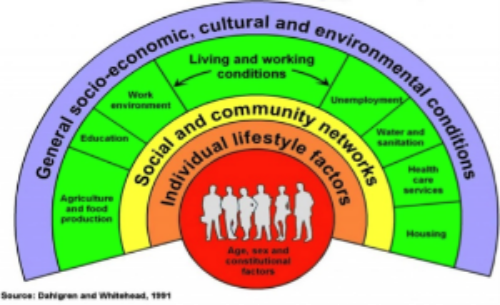~Written by Joann Varickanickal (Contact: joann.varickanickal@gmail.com)
Source: Communitygardens.org
Community Gardens in Developed Regions
Community gardens are either individual plots or collectively cultivated gardens, and there is often some form of public ownership (Jermé & Wakefield, 2013). There are various levels of commitment from local citizens. For example, NeuLand, a community garden in Cologne, Germany is run by a charitable organization with five paid staff members, a managing committee, about 20-30 committed gardeners, and about 40 occasional gardeners (Follmann & Viehoff, 2014).
In the Western World, community gardens have become popular because they are often viewed as a way to advocate for sustainable social and ecological change through a bottom-up approach (Follmann & Viehoff, 2014). Thus, they have proven to have an important impact on the health of citizens in various regions.
Health Benefits
Community gardens have specifically increased access to healthy foods in marginalized regions, consequently, alleviating issues of food poverty (Jermé & Wakefield, 2013). In order to increase the consumption of fresh vegetables, the Victory Garden program was founded in the United States during World War II (Armstrong, 2000; Chan et al., 2015). This led to a 40 percent increase in the consumption of fresh vegetables (Armstrong, 2000). Today, community gardens are still used to ensure that everyone has equitable access to fresh produce. One study revealed that households who did not participate in community gardens consumed fruits and vegetables 3.3 times per day (Alaimo, Packnett, Miles, & Kruger, 2008). In comparison, households with an individual involved in community gardens had a daily consumption rate of 4.4 (Alaimo et al., 2008).
When community gardens are properly implemented and utilized, they can be an important source of empowerment for local citizens (Follmann & Viehoff, 2014). They can provide a space for productive work, interaction with each other, intercultural engagement and knowledge exchange (Follmann & Viehoff, 2014; Armstrong, 2000; Chan et al., 2015). Thus, they become a symbol of unity and increase neighborhood pride (Armstrong, 2000). This social capital is important to increase psychological support (Chan et al., 2015). As a result, community gardens have been established as a component of health promotion (Armstrong, 2000).
Policy Development and Citizen Engagement
Overall, the focus on community gardens is to foster a greater quality of life and community rather than consumption and individualism (Follmann & Viehoff, 2014). In order to continue to foster sustainable community gardens, policy development processes must be examined (Jermé & Wakefield, 2013). Local citizens must be able to participate in the development of policies, and the policies must ensure that citizens have access to gardens that are fairly allocated (Jermé & Wakefield, 2013). Success also depends on a collaborative approach between the various government agencies involved (Jermé & Wakefield, 2013).
References:
Alaimo, K., Packnett, E., Miles, R. a., & Kruger, D. J. (2008). Fruit and Vegetable Intake among Urban Community Gardeners. Journal of Nutrition Education and Behavior, 40(2), 94–101. doi:10.1016/j.jneb.2006.12.003
Armstrong, D. (2000). A survey of community gardens in upstate New York: Implications for health promotion and community development. Health & Place, 6(4), 319–327. doi:10.1016/S1353-8292(00)00013-7
Chan, J., DuBois, B., & Tidball, K. G. (2015). Refuges of local resilience: Community gardens in post-Sandy New York City. Urban Forestry and Urban Greening, 14(3), 625–635. doi:10.1016/j.ufug.2015.06.005
Follmann, A., & Viehoff, V. (2014). A green garden on red clay: creating a new urban common as a form of political gardening in Cologne, Germany. Local Environment, 20(10), 1148–1174. doi:10.1080/13549839.2014.894966
Jermé, E. S., & Wakefield, S. (2013). Growing a just garden: environmental justice and the development of a community garden policy for Hamilton, Ontario. Planning Theory & Practice, 14(3), 295–314. doi:10.1080/14649357.2013.812743


